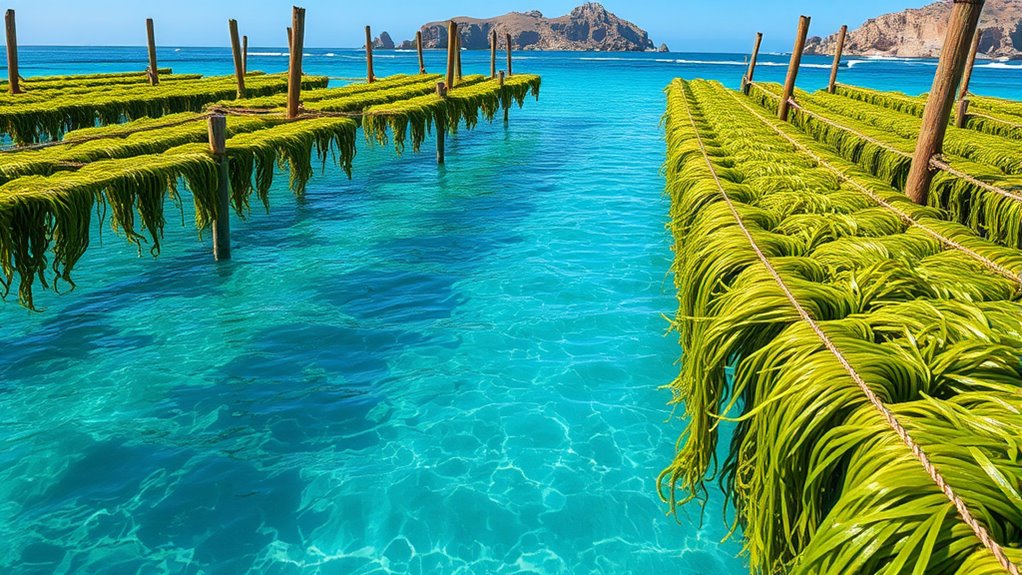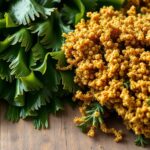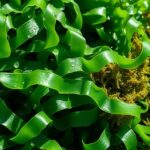Seaweed farming is a sustainable and eco-friendly form of aquaculture that benefits marine ecosystems. By using gentle, selective harvesting methods, you can support healthy regrowth and prevent wild stock depletion. It also improves water quality by absorbing excess nutrients, which reduces harmful algal blooms and boosts biodiversity. Additionally, seaweed acts as a natural carbon sink, helping fight climate change. Continue exploring to discover how responsible practices can promote long-term ecological health and sustainable industry growth.
Key Takeaways
- Sustainable seaweed farming employs gentle harvesting methods that allow natural regrowth and prevent depletion of wild stocks.
- Seaweed acts as a natural water filter, absorbing excess nutrients and reducing harmful algal blooms, supporting marine health.
- Proper cultivation enhances biodiversity by providing habitats without disturbing seabeds or marine organisms.
- Seaweed farming sequesters carbon and requires no chemicals or freshwater, contributing to climate change mitigation.
- Responsible practices promote long-term ecosystem health, balancing economic growth with ecological preservation in aquaculture.

Have you ever wondered how seaweed farming benefits both the environment and local economies? When you explore the process, you’ll see that the harvesting methods used are key to maintaining sustainability and minimizing ecological disruption. Unlike traditional fishing, where overharvesting can harm marine ecosystems, seaweed harvesting often involves gentle, selective techniques that allow the seaweed to regrow naturally. For instance, farmers may cut mature seaweed at specific points, leaving the roots intact so that new growth can develop rapidly. This approach ensures that the harvesting process stays sustainable, preventing depletion of wild stocks and helping sustain the health of surrounding marine life. Because these methods are designed to be low-impact, they considerably reduce the environmental footprint of seaweed farming. This careful approach means that harvesting doesn’t disturb seabeds or harm other marine organisms, making it a more eco-friendly alternative to destructive fishing practices.
The environmental impact of seaweed farming is largely positive, especially when you consider how it can improve water quality and support biodiversity. Seaweed acts as a natural filter, absorbing excess nutrients like nitrogen and phosphorus that can cause harmful algal blooms and dead zones. When you participate in or support sustainable harvesting methods, you’re helping to maintain these natural filtration systems, which benefits entire ecosystems. Moreover, seaweed farms provide habitat and shelter for various marine species, increasing local biodiversity. Because seaweed farms don’t require fertilizers or pesticides, they don’t introduce harmful chemicals into the water, unlike some land-based agriculture. This means less pollution and a healthier environment overall. Additionally, seaweed farming requires no freshwater input, making it an eco-friendly option in regions facing water scarcity.
You’ll also find that the environmental impact of seaweed farming extends beyond the water. It can help combat climate change by sequestering carbon—an effect that’s amplified when harvesting methods are carefully managed to ensure continuous growth and absorption. Cultivating seaweed is a sustainable activity that doesn’t produce greenhouse gases or waste, further reducing its footprint. When you support or engage in responsible seaweed farming, you’re aiding in climate mitigation efforts while promoting a sustainable food source. Moreover, adopting sustainable practices in seaweed farming ensures the long-term health of marine ecosystems and promotes resilience against environmental challenges. The combination of eco-conscious harvesting methods and the environmental benefits of seaweed farming proves that this industry can be a crucial part of sustainable aquaculture. It’s a practice that balances economic growth with ecological preservation, making it a smart choice for the future of our oceans.
Frequently Asked Questions
How Does Seaweed Farming Impact Local Marine Biodiversity?
You might notice that seaweed farming positively impacts local marine biodiversity by enhancing marine habitats and supporting various species interactions. As you engage with these farms, they create new structures that provide shelter and food for fish and invertebrates, boosting species diversity. Additionally, healthy seaweed beds help filter water and maintain ecosystem balance, promoting a resilient environment where marine life thrives and interactions flourish.
What Are the Economic Benefits for Small-Scale Farmers?
You gain enormous economic benefits as a small-scale farmer, transforming your livelihood with the power of seaweed cultivation. Market diversification allows you to tap into multiple revenue streams, making your income more stable than ever before. This practice can turn your modest efforts into a thriving enterprise, providing financial security and resilience. With consistent harvests, you’re not just surviving—you’re flourishing in a way that could reshape your entire community’s economy.
How Can Seaweed Farming Be Integrated With Other Aquaculture Practices?
You can integrate seaweed farming with other aquaculture practices by developing multi-trophic systems, where different species coexist and benefit each other. For example, combining seaweed cultivation with fish or shrimp farming creates an integrated system that improves water quality and resource efficiency. This approach allows you to maximize productivity, reduce waste, and promote sustainability, making your aquaculture operation more resilient and environmentally friendly.
What Are the Challenges in Scaling Sustainable Seaweed Production Globally?
Scaling sustainable seaweed production globally faces challenges like complex scaling logistics and limited market access. You’ll need to develop efficient supply chains to handle increased production without harming ecosystems. Additionally, expanding market access requires building consumer awareness and establishing reliable distribution channels. Overcoming these hurdles demands coordinated efforts between farmers, governments, and businesses, ensuring that growth is environmentally responsible and economically viable for all involved.
How Does Seaweed Farming Contribute to Carbon Sequestration Efforts?
Seaweed farming actively contributes to carbon sequestration by capturing carbon dioxide during growth, helping to reduce greenhouse gases in the atmosphere. As you farm seaweed, you’re engaging in carbon capture, which lowers overall greenhouse gas levels. Seaweed absorbs CO2 efficiently, making it a natural tool in combating climate change. Your efforts in sustainable aquaculture support this process, turning seaweed into a valuable resource for carbon storage and environmental health.
Conclusion
As you explore seaweed farming, you’ll discover how it naturally aligns with sustainable aquaculture, offering benefits that seem almost too good to be true. When you see the positive impacts on ecosystems, the boost to local communities, and the ease of integrating these practices, it feels like fate has brought everything together. Ultimately, embracing seaweed farming isn’t just a choice—it’s a fortunate coincidence that can shape a healthier planet, one harvest at a time.
Ilana has been a vegan for over 10 years. She originally made the switch for health reasons, but soon found herself becoming more and more passionate about the ethical and environmental implications of a vegan lifestyle. Ilana is the author of The Graceful Kitchen, a blog all about veganism. She loves to cook up delicious and nutritious vegan meals, and share her recipes with others who are interested in leading a cruelty-free life. Ilana is also a strong advocate for using whole foods as the foundation of a healthy diet, and believes that going vegan is one of the best ways to achieve this.















